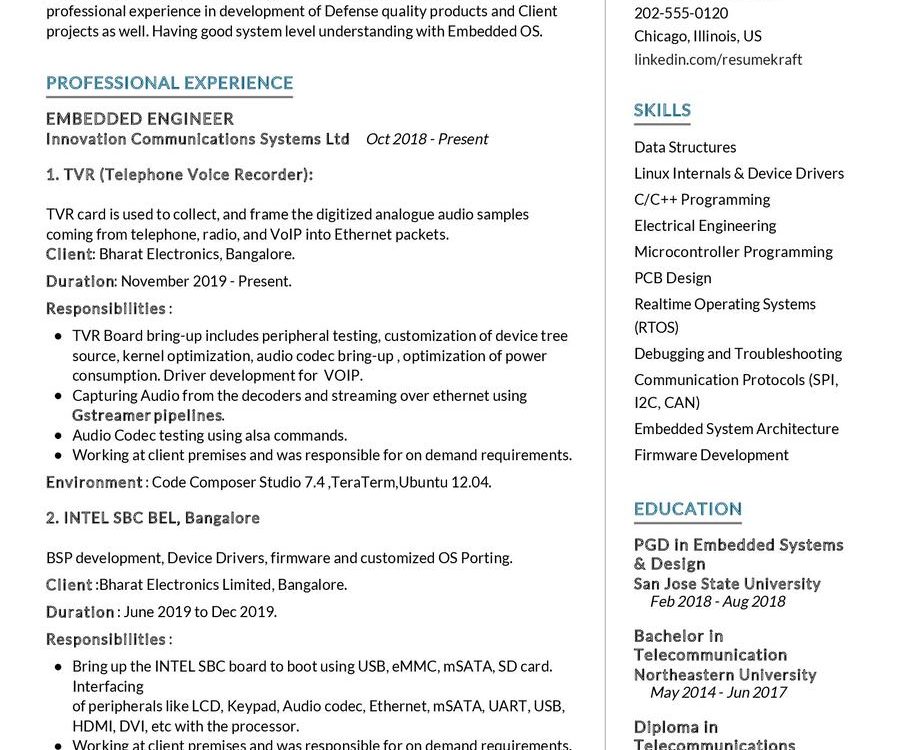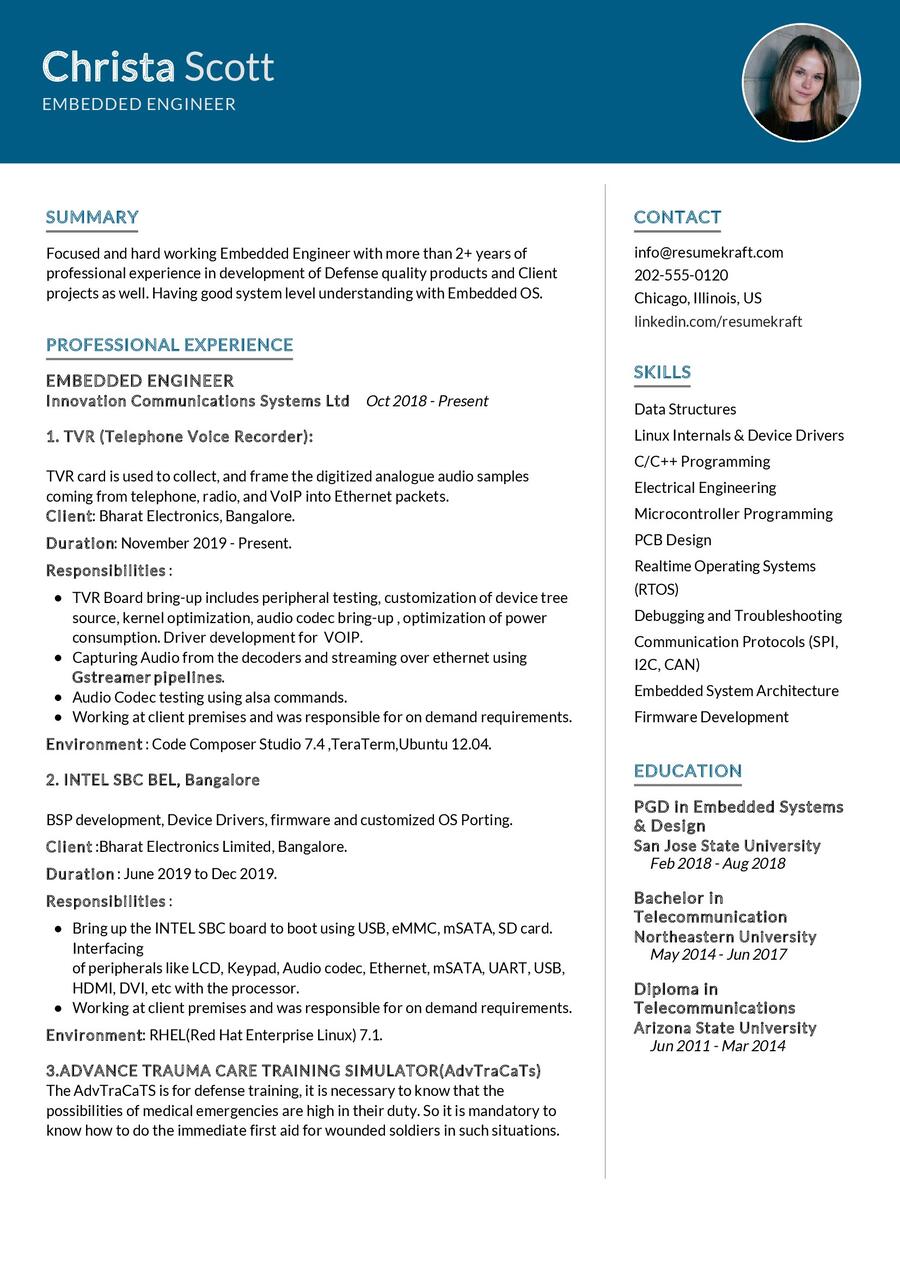Exploring the Role of an Embedded Engineer
As technology advances at an unprecedented pace, the role of an Embedded Engineer becomes increasingly crucial in the world of innovation and automation. This position requires a unique blend of technical prowess and problem-solving skills to design and develop embedded systems. Let’s delve into the multifaceted role of an Embedded Engineer, understanding the key responsibilities, necessary skills, and how to craft an effective CV for this dynamic field.
Job Requirements for an Embedded Engineer
Becoming an Embedded Engineer involves meeting specific requirements to excel in this challenging yet rewarding role. Here’s a detailed look at the prerequisites:
- A Bachelor’s or Master’s degree in Electrical Engineering, Computer Engineering, or a related field, showcasing a strong foundation in the technical domain.
- Proficient knowledge of programming languages commonly used in embedded systems, such as C, C++, and assembly language.
- Hands-on experience in hardware design, including knowledge of microcontrollers, microprocessors, and other embedded systems components.
- Problem-solving skills and the ability to troubleshoot and debug complex embedded systems.
- Understanding of communication protocols like SPI, I2C, UART, and experience in interfacing with various sensors and actuators.
- Strong teamwork and communication skills to collaborate effectively with cross-functional teams.
- Experience with real-time operating systems (RTOS) and familiarity with industry standards and compliance.
- Continuous learning mindset, staying updated on emerging technologies in the embedded systems field.
Adding certifications related to embedded systems, such as Certified Embedded Systems Professional (CESP), can enhance your profile and make you stand out in the competitive job market.
Responsibilities of an Embedded Engineer
The role of an Embedded Engineer is diverse and involves a range of responsibilities to ensure the seamless functioning of embedded systems. Here are the key tasks associated with this role:
- Designing and developing embedded systems for various applications, considering both hardware and software aspects.
- Collaborating with hardware and software engineers to integrate components and systems effectively.
- Conducting testing and debugging to ensure the reliability and performance of embedded systems.
- Optimizing code and system performance to meet specific requirements and constraints.
- Working on projects that involve IoT (Internet of Things) integration, requiring connectivity and communication between embedded devices.
- Staying informed about industry trends and advancements to incorporate the latest technologies into projects.
- Ensuring compliance with industry standards and regulations in the development of embedded systems.
Each responsibility comes with its unique challenges and learning opportunities, shaping you into a skilled Embedded Engineer.
Crafting a Strong Embedded Engineer CV
Your CV is your ticket to showcasing your skills and experience effectively. Here are some tips to create a compelling Embedded Engineer CV:
- Highlight specific projects you’ve worked on, detailing your contributions and the impact on the embedded systems.
- Emphasize your programming skills and proficiency in languages like C, C++, and assembly.
- Showcase your experience with hardware design and familiarity with microcontrollers and microprocessors.
- Include any certifications or training related to embedded systems to demonstrate your commitment to continuous learning.
- Quantify your achievements, such as improving system efficiency or successfully implementing a complex embedded system.
- Tailor your CV for each job application, aligning your skills and experiences with the specific requirements of the role.
Your CV is a reflection of your journey as an Embedded Engineer, so make it stand out by presenting a clear narrative of your skills and accomplishments.
Embedded Engineer CV Summary Examples
Your CV summary is the first impression you make on potential employers. Craft a powerful summary that encapsulates your expertise and value. Here are some examples to inspire you:
- “Experienced Embedded Engineer with a proven track record in designing and implementing innovative embedded systems. Proficient in C and C++, with a focus on optimizing code for maximum efficiency.”
- “Dedicated Embedded Engineer with a strong background in hardware design and a passion for creating robust and reliable embedded systems. Skilled in troubleshooting and debugging to ensure optimal performance.”
- “Results-driven Embedded Engineer specializing in IoT integration, with a history of successful projects that enhance connectivity and communication between embedded devices.”
Your CV summary sets the tone for your entire CV, so make it impactful and tailored to the specific role you are applying for.
Building an Experience Section for Your Embedded Engineer CV
Your experience section is the core of your CV, showcasing your journey as an Embedded Engineer. Here are some examples to guide you:
- “Led the development of an embedded system for a smart home automation project, resulting in a 30% improvement in energy efficiency.”
- “Contributed to the design and implementation of a medical device with embedded systems, ensuring compliance with industry regulations and standards.”
- “Collaborated with cross-functional teams to integrate embedded systems into automotive applications, enhancing safety and performance.”
Each experience is a chapter in your career story, illustrating your ability to tackle challenges and deliver successful outcomes.
Education Section for Your Embedded Engineer CV
Your educational background is a critical aspect of your CV, providing context for your technical expertise. Here’s how you can present your education in your CV:
- Master of Science in Electrical Engineering, XYZ University, a journey of in-depth learning and specialization, 2018.
- Bachelor of Science in Computer Engineering, ABC University, the foundation of your expertise in embedded systems, 2014.
- Embedded Systems Certification, Embedded Systems Institute, showcasing your commitment to continuous learning, 2019.
Each educational qualification contributes to your overall expertise as an Embedded Engineer, highlighting your academic achievements and commitment to the field.
Essential Skills for Your Embedded Engineer CV
Your skill set is a valuable asset, and your CV should reflect the diverse range of skills you’ve acquired. Here are essential skills for an Embedded Engineer:
Technical Skills:
- Programming languages: C, C++, Assembly.
- Hardware design and development.
- Microcontroller and microprocessor knowledge.
- Embedded systems testing and debugging.
- IoT integration and connectivity.
- Real-time operating systems (RTOS).
Soft Skills:
- Problem-solving abilities.
- Effective communication and teamwork.
- Attention to detail.
- Adaptability and continuous learning.
Each skill is a tool in your toolbox, contributing to your success as an Embedded Engineer.
Common Mistakes to Avoid in Your Embedded Engineer CV
As you craft your CV, steer clear of common mistakes that can impact your chances of landing your dream job. Here are some pitfalls to avoid:
- Using a generic CV for multiple applications, instead of tailoring it to the specific job requirements.
- Focusing solely on job duties, neglecting to highlight your achievements and contributions to projects.
- Omitting a cover letter, missing an opportunity to provide a personal touch to your application.
- Overloading your CV with technical jargon, potentially alienating non-technical readers.
- Neglecting to proofread, risking errors that could impact your professional image.
Avoiding these mistakes ensures that your CV presents a clear and compelling picture of your skills and experiences as an Embedded Engineer.
Key Takeaways for Your Embedded Engineer CV
As you conclude this comprehensive guide, remember these key points while crafting your Embedded Engineer CV:
- Highlight specific projects and achievements to showcase your practical experience.
- Emphasize your programming skills and proficiency in languages like C, C++, and assembly.
- Quantify your achievements, demonstrating the impact of your work on embedded systems.
- Include a section on continuous learning, showcasing certifications and training related to embedded systems.
Finally, feel free to utilize resources like AI CV Builder, CV Design, CV Samples, CV Examples, CV Skills, CV Help, CV Synonyms, and Job Responsibilities to create a standout application and prepare for the Embedded Engineer job interview.
Armed with these insights and tips, you are now ready to craft a CV that is a true reflection of your journey, your skills, and your aspirations. Remember, your CV is not just a document; it is a canvas where you paint your career story, a story of growth, learning, and innovation. Best of luck!


